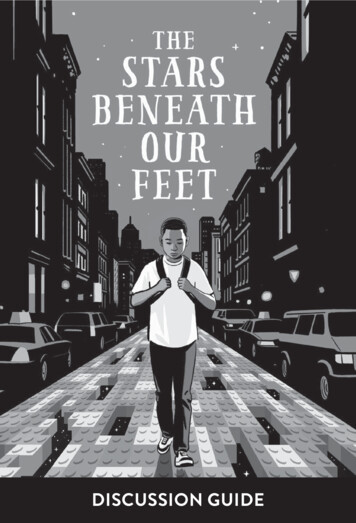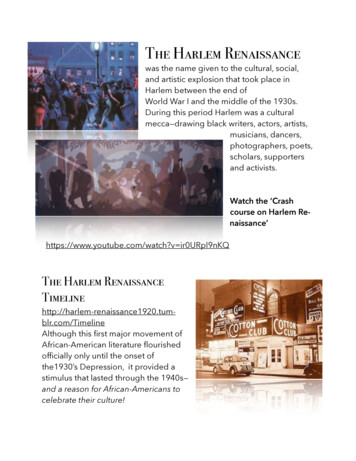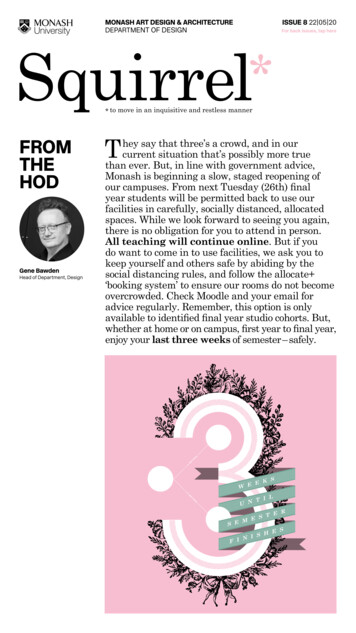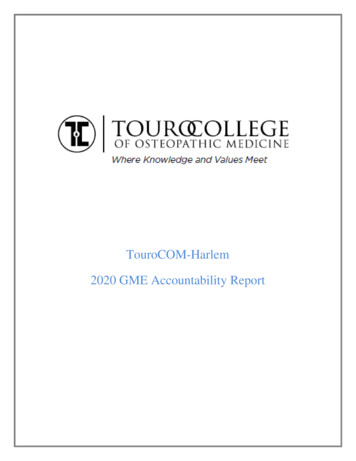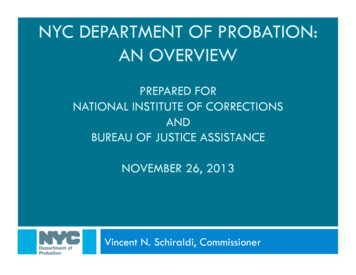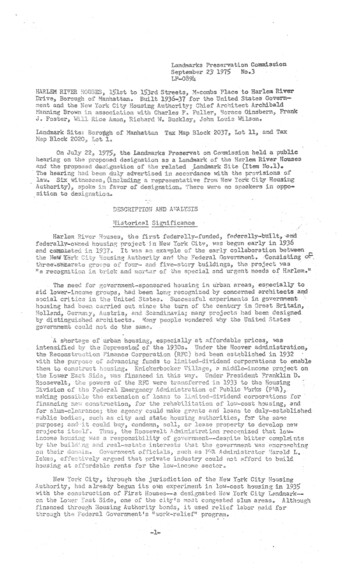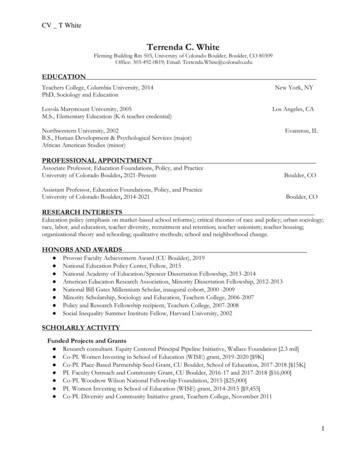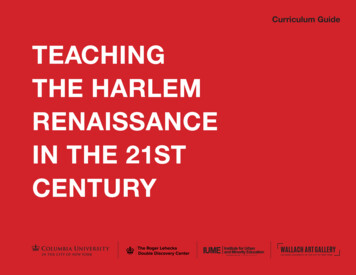
Transcription
Curriculum GuideTEACHINGTHE HARLEMRENAISSANCEIN THE 21STCENTURY1
Introduction5CURRICULUM MODULESG R A D ES 9 –12GRADES 6–8Harlem Renaissance Remixed: A Humanities Module12331Speaking Our Truths: Visualizing Then and Now135Harlem Renaissance and the Threading of Meaning47The Call to Action: The Harlem Renaissanceand Community-Based Activism143A Dream Book for Existing Otherwise57Learning Objectives/StandardsInstruction StrategiesBibliographyAuthor Bios166172174184Home Art: Hughes, Woodson, and MeKATIE HARLAN ELLERThen & Now: A Photographic JourneyAYELET DANIELLE ALDOUBY AND ANNE LATTNERIN COLLABORATION WITH ARTIST MAREN HASSINGERSTEPHANIE BOGGS AND CARINA MAYESARAH GERTH V.D. BERG, NANCY LESKO, RACHEL MEWESAND JACQUELINE SIMMONS7The Music of the Harlem Renaissance: Blues Performanceand Analysis for Contemporary Young Musicians83MERCEDES YVONNE LYSAKERExploring the Harlem and Italian RenaissancePeriods Through Radio PlaysELAINE PERLMAN105MARGARET BANKSJUDITH BURTONMICHELLE GIBBS-SPENCER
4
IntroductionIn early 2020, after a university-wide meeting about the ongoingcentennial of the Harlem Renaissance, we reflected on the far-reachingimpact of the Harlem Renaissance as a vibrant artistic, political,educational, and cultural movement across time and space.We asked ourselves, what if the Centennial were an opportunityto return the Harlem Renaissance to classrooms and provide youngpeople—particularly Black youth in the Harlem community that we allserve—with new lenses of inquiry to explore a range of themesof this historic period and to make connections to contemporary local,national, and global contexts? This curriculum guide is the result ofthose conversations and our collective response to a call to action.This project represents the intellectual rigor and creativity thatis possible through an intentional partnership of different units across theUniversity that are focused on engaging the community in meaningfulways. Students and faculty with a passion for and expertise in thecontent of the Harlem Renaissance partnered with the Wallach ArtGallery, The Double Discovery Center, and Institute for Urban andMinority Education at Teachers College, Columbia University tovolunteer the use of their pedagogical skills to design and createcurriculum modules that (re)present the Harlem Renaissance withan emphasis on new scholarship about the period and its ongoingimpact on contemporary life. The module authors sought to provideteachers and community educators with curricula that are studentcentered and that use critical inquiry approaches to encouragestudents’ examination of the materiality of different texts and mediaas the means for exploring and synthesizing content to arriveat their own new understandings of the Harlem Renaissance.Between the launch of this project and its release, New York City, alongwith the rest of the world, was brought to halt by COVID-19. In late May2020 protests over the death of George Floyd focused attention on thesystemic racism that is pervasive across our nation. In this momentof heightened awareness of the need for change and a recognitionof the role that education can and must play, the content of thisresource is even more vital, so all young people can develop sharedunderstandings of and appreciation for the sociocultural relevance andvalue of the Harlem Renaissance then and now. This project elevates5and exalts the experiences of Black Americans as an essential partof the call for and drive towards social change and transformation.While rooted in the history of the Harlem Renaissance, it illuminatespoints of contemporary connectivity for teachers and students whoare looking to mobilize the past to better understand the present.This project would not be possible without the dedication and hard workof each of the module authors. We thank them for their unwaveringcommitment to this project. We also salute the contributions of StephanieLitchfield, Wallach Gallery attendant; Natasha Mileshina, resourcedesigner; and Tonia Payne, resource copy editor.In working on this project, individually and collectively, we have learnedmuch more about this important period in American history the HarlemRenaissance never truly ended but is timeless in its significance andimpact on many aspects of our society. Just as the artists in theWallach Art Gallery’s Uptown Triennial 2020 exhibition look to the visualculture of the Harlem Renaissance to construct new interpretativeframes that visualize and make meaning of Black life, past and present,we invite you and your students to experience this guide as a toolto do likewise. We hope that your immersion into the HarlemRenaissance through this guide is a point of entry into a journeyof discovery of the robust history of Blacks in America one that toooften has been marginalized but that provides critical thematicanchors to understanding our America.Teaching the Harlem Renaissance for the 21st CenturyProject Directors:kecia hayes, PhDExecutive DirectorThe Double Discovery CenterJennifer MockAssociate Director Education and Public ProgramsWallach Art GalleryErica Walker, EdDProfessor of Mathematics Education and DirectorInstitute for Urban and Minority EducationTeachers College, Columbia University
Grades 6–8
K ATIE H A R L A N EL L ERHome Art:Hughes, Woodson,and MeESSENTIAL QUESTIONS What is “home”? How does one’s sense of home inform one’s art?7
LEARNING OBJECTIVES Introduce upper elementary and lowermiddle-school learners to the people,artists, art, poetry, and ideas of the HarlemRenaissance and how those resonate onehundred years later Study and make sense of various poetic forms Study the Great Migration and its impact onHarlem as a place, and on Harlem’s peopleand its art, from the Harlem Renaissancethrough today Explore Harlem Renaissance poets, includingLangston Hughes and many female poets, asan entry point into poetry and its themes andforms, and into Harlem Renaissance literature Grapple with complicated questions aboutthe idea of home, including issues of migrationand immigration, race, history, memory,culture, and identity Study Romare Bearden, a jazz-inspiredcollage artist who was born in North Carolina,migrated to Harlem, and lived among manyHarlem Renaissance artists Connect Jacqueline Woodson’s free versememoir, Brown Girl Dreaming, to themes ofhome, identity, art, as well as to the workof Langston Hughes, as she reconciles herconnection to places as disparate as Ohio,South Carolina, and Brooklyn Make sense of the unit’s themes anddemonstrate understanding of the people,art, and literature of the Harlem Renaissancethrough a co-created work of art and writtenpiece presented on Artists Day Perceive events and circumstances from theviewpoint of others, including people in racialand cultural groups and/or who live underpolitical and economic systems different fromtheir own Understand the relationships among variousartistic genres and media and the connectionsbetween sociohistorical and/or sociopoliticalevents and the arts (e.g. how art is createdand appreciated) Understand the link between the artist andsociety and how art forms can advocatepositions Use creative and artistic expressions toexplore both academic and nonacademictopics in relation to self and others and tofacilitate meaningful connections with theworld of artNOTE:This module is also appropriate for grades fourand five.OVERVIEWThe Harlem Renaissance reflects a period offormative Black culture and art in the earlytwentieth century. In view of its influence,Harlem connected many people and placesaround the world (Soto, 2008). Theseconnections impacted art and culture from thetime of the Harlem Renaissance and certainlyto us today. In this unit, students considerthe essential question, “What is home?”through poetry, art, people, ideas, and history.Additionally, this unit supports academicstandards related to reading, writing, speakingand listening, poetry, social studies, music,visual arts, and media arts while encouragingstudents to engage complex questions aboutrace and further develop their own racialliteracy. This unit is an accessible place forstudents to enter into this content, particularlythose who have minimal knowledge of theHarlem Renaissance. Therefore, students willexplore the arts and lives of Langston Hughes,Romare Bearden, and other artists whilesimultaneously considering themes of : whatmakes a home? What is “home” to you andwhat can home mean for others? How doesone’s sense of home inform one’s art?The module begins with an introduction ofLangston Hughes’s “I, Too, Sing America,”foreshadowing the unit’s themes of home, art,and the impact of the Harlem Renaissance asa “conduit of culture” (Collier 2012) into ourlives today. It also asks students to considerrace as a thoroughgoing social constructin the U.S.Lessons 1–3 focus on the Great Migrationand its impact on the arts and the HarlemRenaissance, and help situate learners in theircommunities as they reckon with persistingracial segregation and white supremacy. Themore students learn about and understand thecauses and effects of the Great Migration, the8
more profoundly its occurrence impacts theirappreciation and understanding of artand culture.Lessons 4–6 explore the Harlem Renaissanceand the key people of that movement. Usinga flipped model of instruction, in whichstudents teach each other, students will doa brief but immersive dive into artists and keyfigures of the period. This helps those withlittle knowledge of the Harlem Renaissancesituate the focus on poetry and art of theperiod in the next set of lessons. First,students learn about Langston Hughes andconnections between his work and that ofcontemporary writer Jacqueline Woodson.Students then study the work of other HarlemRenaissance poets, mostly women. There areexisting standards for reading poetry at thisage in most states, and these short, powerful,and varied texts provide entry into HarlemRenaissance literature for older childrenand early adolescents.Lessons 6–9, students study RomareBearden, a collage artist who brings many ofthe unit themes together. As students meetBearden, they will also learn ways to study artand music, specifically through listening andresponding to the Branford Marsalis Quartet’salbum Romare Bearden Revealed.STUDENT JOURNALSThroughout the unit, as well as exploring,reading, appreciating, and creating art,students keep journals that help themsynthesize their reflections of the essentialquestion “What is home?” Over the courseof the module, this question becomesincreasingly complicated by factors such asthe Great Migration and questions about howart reflects various notions of home. Possiblequestions to address include the following:9GREAT MIGRATION Where is home for one who leaves their home? If a person leaves an oppressive system, wasthat really home? Does home have to be safe? What makes a home safe and what reasonswould make a person desire to leave?ART AND NOTIONS OF HOME: What do our senses tell us about memoryand home? How does the artist’s process reflect home? Why do artists include and value ideas ofhome in their work? What does art teach us about our own ideasof home?Each lesson includes a prompt for reflectionon the lesson’s activities. Finally, along with theculminating Artists Day celebration, studentswill write a piece about their evolving answerto the question “What is home?” Students cankeep paper journals or hard copies, or theycan use a digital tool such as Seesaw, whichprovides a safe and dynamic platform forjournaling and collecting information.GROUP STRUCTURESThe module mostly calls for collaborativegroup work and partnerships, with somemovement toward independent, self-selectedand directed work. At times, students workin pairs or smaller groups, but a classwidediscussion is recommended so students canmore readily make meaning of the complexideas alongside their peers and teachers.That said, you may decide it is better for yourstudents to work collectively. Since the ideathat home reflects one’s communityand relationships is central to this module,do what makes the most sense for yourparticular students.This module was originally developed tocomplement Jacqueline Woodson’s Brown GirlDreaming. Woodson uses Langston Hughes’spoem “Dreams” as the beginning for herfree-verse memoir, and Woodson writes otherpoems about Hughes. Many of the lessonsinclude “Extension Activities” with suggestionsincorporating Woodson’s text, which alsoteaches poetry, investigates the question“What is home?” and draws connectionsto the Great Migration and the experienceof being Black in America in the 1960s.
CONTEXTThe module begins with an introductionto Langston Hughes’s poem “I, Too, SingAmerica,” which foreshadows the modulesthemes of home, art, and the impact of theHarlem Renaissance as a “conduit of culture”into our lives today. It also asks studentsto consider race as a thoroughgoing socialconstruct in the U.S. Unfortunately, the GreatMigration is minimized in K–6 social studiesstandards across the U.S. This knowledgeis critical in order for students to understandthe history and continuing systemic racialdisparities in their hometowns and states. Forexample, an area near the city for which thisunit was originally created was home to oneof the largest plantations in the Southeast.The region’s economy was built on tobaccoproduction for decades after the end of theplantation system (Discover Staff, 2019). Froma quick glance at the city’s demographicaldata and maps, systemic racism is still visuallyevident (“Durham, North Carolina PopulationInteractive Map,” 2010). Nevertheless, theGreat Migration does not appear in NorthCarolina’s social studies standards until eighthgrade, and even then only in one parentheticalexample (“North Carolina Essential StandardsEighth Grade Social Studies,” 2019). Yetthousands of people born in North Carolinamigrated north as a result of persistentviolence and racism (McKinley & McKinley,2006). New York became home to more thantwice the number of North Carolinians thanany other northern state. While this fact isspecific to North Carolina, the connectionto Harlem is not unlike many connectionsstudents might make between Harlem andthe Harlem Renaissance and their ownhometowns, states, local artists and artsscene, histories, and current cultureand movements.In considering the key questions of thismodule, painter Romare Bearden’s artwork,alongside the Branford Marsalis Quartet’smusic, provides deeper connections betweenthe art and music of the Harlem Renaissanceand contemporary jazz. These art integrationsbuild upon the earlier lessons in the module,underscoring the influence of the HarlemRenaissance, the impact of the GreatMigration, the ways in which poetry influencesart and music, and continued exploration ofthe module’s essential questions.Romare Bearden was born in North Carolinabefore his family migrated to Harlem, wherehe was raised in the middle of the HarlemRenaissance (Greenberg, 2007). In fact, theBearden home was a hub for many HarlemRenaissance artists, including LangstonHughes and Duke Ellington. His paintingsand collages reflect on themes of home andidentity, as well as his lived experiences as aBlack American in the twentieth century.CULMINATING PROJECTArtists Day celebrates work from a formativeassessment that draws on the contentsof the entire module in an effort for studentsto explore and present a synthesis of theirnew knowledge.On Artists Day, students will present projectscompleted as a formative assessment.The Artists Day project reflects the life andcontributions of artists, working in a varietyof artistic media, in addition to thosespecifically studied in the module. SeeLesson 10 for details as well as suggestionsfor assessment and rubrics.In 2003, influenced by Bearden’s art, theBranford Marsalis Quartet released their albumRomare Bearden Revealed, a collection of jazzpieces paired with and inspired by Bearden’sart (Marsalis, 2020). Studying Bearden andthe Branford Marsalis Quartet side by sideencourages a wider view of the HarlemRenaissance, its influence, and a multimodalexploration of themes of “home.”10
ACTIVITIES (one to two class periods)LESSON 1I, Too, Am America As students enter, play a song or two fromRomare Bearden Revealed by the BranfordMarsalis Quartet (see Materials and Resourcesfor a streaming link). Students write or journal a response to thequestion “What is home to you?” In groups, students discuss one spread ofillustrations from Jason Collier’s picture bookI, Too, Am America, which uses the text fromLangston Hughes’s poem. From the images,students infer the story being told and recordtheir responses. Call on groups to share the inferences theymade about their assigned spreads and howthey think the images tell the story of thepoem. Focus, for now, on the story being toldin the illustrations, not on the Hughes poemitself. After discussing the inferred story of theillustrations, distribute copies of the poem “I,Too, Am America” for students to read usingthe “read three ways” strategy described inTeacher Strategies. Connect the story Jason Collier was tellingwith the reading of Hughes’s poem. Note the actual events Collier depicts,including that of the Pullman porters“rescuing” the art of the Black people in thelast car of the train. Note how the illustrations touch on severalpoints of American history. Ask students to write and/or discuss thequotation from Collier about racial “progress”on the book jacket.11 Share with students that the art from thePullman porters is not unlike the art of theHarlem Renaissance: the literature, music,visual art, dance, and so on that were birthedduring the 1920s and 1930s but that continueto inform our literature and art today, onehundred years later.TEACHER STRATEGIESREAD THREE WAYS POETRY STRATEGYUsing the recording of “I, Too,” students will“read” the poem three ways: with their pen (or highlighter, etc.) with their ears and with their voices.Step 1: Play the recording and ask studentsto “read with their pen.” Students willlisten and follow along with the recording,while “reading with their pen”: using it tounderline words or phrases standing out asthey listen.Step 2: Play the recording a second timeand ask students to “read with their ears.”This time, students will listen with eyesclosed. Ask them to notice what standsout, perhaps some of the same words orphrases from the first “reading,” perhapssome new ones. Pause at the end sostudents can underline the words/phrasesthat stood out when they just listened.Step 3: For the final “read,” students“read with their voices.” To do this, theteacher reads the entire poem aloud andeach student joins in on just those wordsthe student underlined during the firsttwo readings. For example, if a studentunderlined “am America” in the first line, thestudent would stay silent when the teacherreads, “I, Too” and then join the teacher
aloud for “am America.” Students continuein this manner until the poem is read in itsentirety. This method highlights the waystudents have individually and collectivelyengaged with the poem.Step 4: Ask students what they noticed aboutthis experience; what stood out?MATERIALS & RESOURCESSTUDENT JOURNALSStudents can keep paper journals or hardcopies, or they can use a digital tool suchas Seesaw, which provides a safe anddynamic platform for journaling and collectinginformation. Romare Bearden Revealed Album by theBranford Marsalis Quartet Copies of “I, Too” by Langston Hughes (oneper student)NOTES TO TEACHERIDEAS FOR EXTENSION ACTIVITIESIn the picture book I, Too, Am America(Hughes, Collier, & Linn, 2012), students spendtime with the illustrations of Hughes’s poem,which feature the additional narrative of thePullman porters. This second story, “told”in illustrations under Hughes’s text, depictsthe Pullman porters gathering newspapers,magazines, and albums from the back ofthe last car—a true story—before sendingthe material they’d gathered“ as a conduit ofculture” into the cotton fields of the South aswell as into the apartments and subway stopsof modern-day Harlem. In addition, there isan illustrator’s note on the book jacket textthat students should discuss. The illustratornotes that he hopes to “show how farAfrican Americans have come as a people inrealizing a vision of equality that Hughes oncedreamed of.” After reading Hughes’s poemand spending time with the second story, dostudents agree with Collier’s statement aboutprogress? Why?CONNECTING TO BROWN GIRLDREAMING:Introduce the connection between Woodsonand Hughes with Hughes’s Poem “Dreams,”which is the epigraph to Brown Girl Dreaming.Use the “read three ways” strategy describedin Teacher Strategies. A recording of Hughesreading “Dreams” can be found here. A copyof the poem can be found here. Audio recording of “I, Too” (found here) Pens/highlighters Jason Collier’s illustrated bookof I, Too, Am America12
LESSON 2One Way TicketACTIVITIES (three class periods)TEACHER STRATEGIES As students enter, consider playing DavidOrnette Cherry’s “Pick Up My Life/One WayTicket” (see Materials and Resources for link).POETRY SCRAMBLE: Students listen to Langston Hughes’s poem“One Way Ticket” if possible also usingthe text in Allison Lassieur’s The HarlemRenaissance: An Interactive History Adventure,which will be important in Lesson 3. Thestudents listen to Hughes’ own voice (seeMaterials and Resources). Students listen to the poem and annotatewords and phrases that stand out to them. Askstudents to consider what the speaker of thepoem is saying about his idea of home. Students use the embedded tool on theJacob Lawrence Migration Series website tocreate a digital poem from “One Way Ticket.”(See one example here and further detailsin Teacher Strategies.) In partnerships or small groups, studentsmap the places referenced by Hughes in “OneWay Ticket.” They can draw on blank maps,create maps on blank paper or chart paper, oruse digital tools, three-dimensional maps, orother options. Students journal a response to the question“What does the Great Migration teach usabout the idea of home?”Students use this link on the Jacob LawrenceMigration Series website to create a poetryscramble using the text from “One Way Ticket.”Step 1: Students are able to select words fromthe poem to create digital artwork. Simpledirections are listed in the link.Step 2: Students can add their digital piecesto a digital journal, or they can email theirfinished piece to themselves to print and addto their journals. One example of a finishedpoetry scramble can be found hereMATERIALS & RESOURCES David Ornette Cherry’s song “Pick Up MyLife/One Way Ticket” Langston Hughes reading “One Way Ticket” Copies of the poem “One Way Ticket”by Hughes (one per student) Pens/highlighters for students Jacob Lawrence Migration Series websitefor poetry scramble Student journals Paper and art supplies for maps Blank map13
NOTES TO TEACHERAfter introducing the unit as a celebrationof the Harlem Renaissance and its impacttoday, students travel back in time to lookat some of the social factors that promptedit, specifically the Great Migration.It is highlyrecommended that teachers watch or listento Isabel Wilkerson’s TEDtalk on the GreatMigration and/or read her book, The Warmthof Other Suns. Wilkerson provides particularinsight into the ways that the Great Migrationimpacted the Harlem Renaissance, as wellas Black art and culture from the HarlemRenaissance through 2020 and beyond. Youcan find Wilkerson’s TEDtalk, “The GreatMigration and the Power of a Single Decision”here, a podcast version of the TEDtalk here, orher book, The Warmth of Other Suns here.This lesson introduces students to LangstonHughes’s significance in the HarlemRenaissance as well as the history of the GreatMigration as addressed in his poem “One-WayTicket.” Students use a multisensory approachto reading, savoring, and annotating poems.Listening to Hughes read his own poetry ishighly recommended.Through mapping the places mentioned inthe poem, students begin to make sense ofHughes’s message while visually exploringgeographical representations of the ideasunderlying the Great Migration, whichprompted the Harlem Renaissance.IDEAS FOR EXTENSION ACTIVITIESCONNECTING TO BROWN GIRL DREAMING:In addition to mapping “One Way Ticket,”students can map Woodson’s poem “each winter”to show the character Jackie’s mother’s trip fromNelsonville, Ohio, to Nicholtown, South Carolina,or they can map “halfway home #1” or “writing #2”to trace Jackie’s family’s movement from SouthCarolinato Brooklyn. Each of these poems offersperspectives on the complicated ideaof home.Allison Lassieur’s The Harlem Renaissance:An Interactive History Adventure connects theGreat Migration to the Harlem Renaissancein an informative and student-friendly, “ChooseYour Own Adventure” style.Find additional information on the GreatMigration here.The Great Migration is minimized in moststates’ social studies standards, which isreflective of the way our society privilegesparticular historical narratives. The narrativeof the Great Migration, by contrast, highlightsone in which Black people were treated inways that prompted millions to leave theJim Crow South for jobs “promised” in theNorth. Highlighting the Great Migrationboth connects students to roots of theHarlem Renaissance and situates students’ongoing understanding of segregationist andsystemically racist policies today.An interactive map that visually depicts racialsegregation today is the Racial Dot Map. It isanother way to demonstrate to students whatprompted the migration of so many BlackAmericans in the early twentieth century aswell as the ongoing legacy of that migration.14
LESSON 3City of RefugeACTIVITIES (one to two class periods)TEACHER STRATEGIES Share an excerpt from Rudolph Fisher’s shortstory “City of Refuge,” specifically the passagein which the protagonist arrives from NorthCarolina and observes, “In Harlem, black waswhite.” (See Materials and Resources.)JOURNAL PROMPT: Using their journals, ask students to makemeaning of this line in a quick write or a shortpoem. Perhaps ask them if they would like toimagine what made Gillis feel this way. Students then share their understandingsof this line in partnerships or small groups,followed by a classwide discussion. This is akey time to draw connections to other socialmovements the students may know, such asthe Civil Rights movement and Black Lives Matter. Read Moving North, a nonfiction book thatbegins with the Great Migration and ends withthe Harlem Renaissance.An open-ended prompt can allow students tomake meaning by writing about their feelings,responses, experiences. Emphasize thatthere are no “correct or incorrect” answerswithout speaking to the author. Explain that,since Fisher is no longer living, we do thebest we can to interpret why it’s a powerfulline. In a quick write, students write only a fewsentences or a poem. The point is to writea quick reaction, for students to get wordsout of their heads and onto paper. Spelling,grammar, and other conventions of formalwriting are low priority. One way to do this isto set a timer for five to seven minutes andask the students to write until the timer stops.If students are stuck, you might prompt themwith, “I think this line means ” or “MaybeRudolph Fisher wanted us to know ” orsomething else open-ended. Following thisquick write, have students dialogue. Studentsdo not need to read their responses aloudunless they choose to, but they should talkwith a partner or group, or with the wholeclass about some of their ideas.One possible scaffold for sharing ideas isto provide partnerships or groups with chartpaper to draw or write about the passagefrom “City of Refuge” after dialoguing aboutit. Students co-construct their ideas in somepresentable way and then share with theclass. Sharing ideas in small groups before theclasswide discussion may provide a meansfor having all students participate in thinkingthrough the way Fisher felt upon his arrivalin Harlem.15
MATERIALS & RESOURCESIDEAS FOR EXTENSION ACTIVITIES “City of Refuge,” a short storyby Rudolph FisherJacqueline Woodson’s picture book This Is theRope is one of very few picture books on theGreat Migration. “Moving North” by Monica Halpern Student journals Chart paperNOTES TO TEACHERRudolph Fisher’s short story “City of Refuge”describes the experience of Gillis, from NorthCarolina, migrating to Harlem, where, hethinks, “In Harlem, Black was White” (page 2).Note: this story is not at a fourth- to sixthgrade reading level. It tells a powerful story,but may need to be abridged and/or readaloud to early adolescent learners.For students living in the southern U.S.: Read Dear Mr. Rosenwald, by Carole BostonWeatherford, about the Julius Rosenwald andthe schools he built specifically for educatingpeople of color in the early twentieth century,in response to the underfunding of schools fornon-White people (Heller, 2015). Learn about Carole Boston Weatherford,a North Carolina author whose books figureprominently in this unit. Ask, “What is the nearest Rosenwald schoolto your school?” One database is here.Students will continue to learn about the GreatMigration in the nonfiction text Moving North.If you do not have access to Moving North,consider one of the following videos, whichconnect the Great Migration to the HarlemRenaissance and highlight severalof its artists. History.com video on the HR (3 minutes) Jacob Lawrence and the Great Migration(6 min.)16
ACTIVITIES (five class periods) Students work in partnerships to facilitateflipped-classroom teaching, in which studentsteach each other.LESSON 4The HarlemRenaissance Student pairs select one person from theHarlem Renaissance to research and teachabout. Highly recommended: using the short,well-written biographies in Black Stars of theHarlem Renaissance. Students spend three to five days get
content of the Harlem Renaissance partnered with the Wallach Art Gallery, The Double Discovery Center, and Institute for Urban and Minority Education at Teachers College, Columbia University to volunteer the use of their pedagogical skills to design and create curriculum modules that (re)present the Harlem Renaissance with


